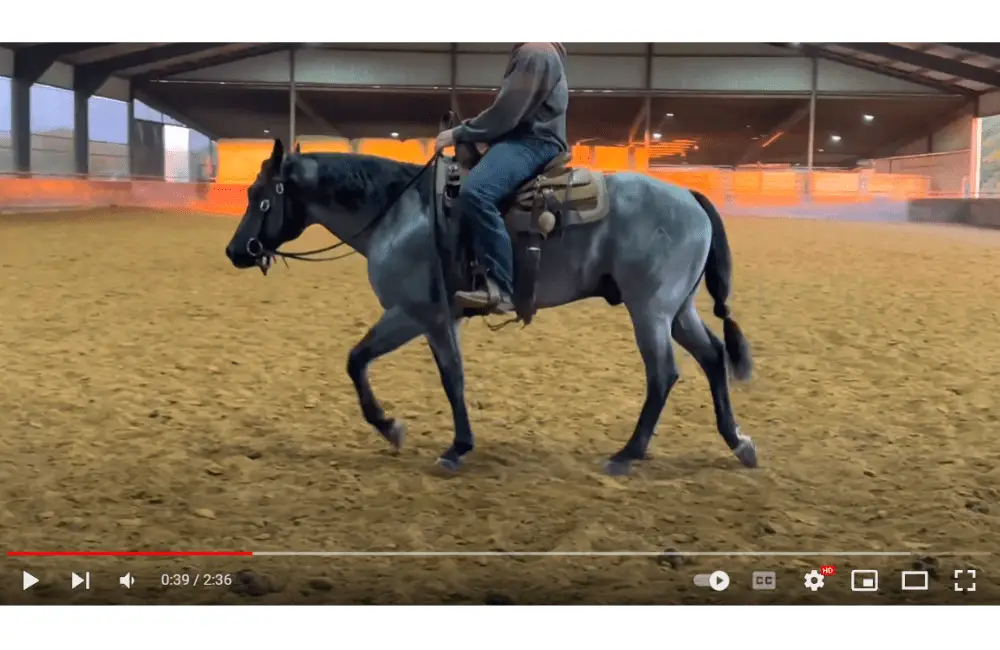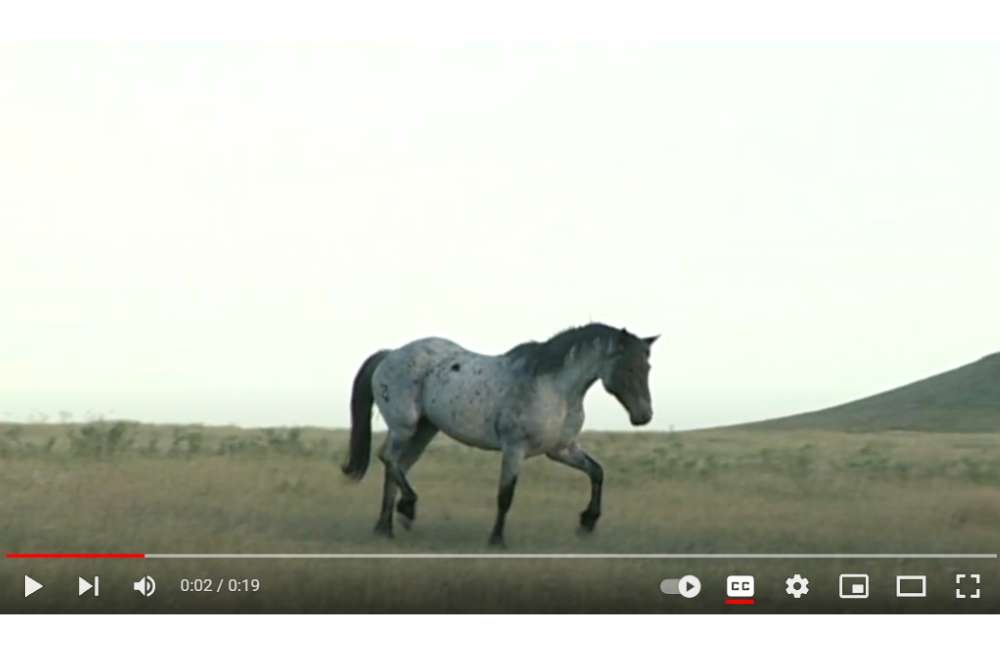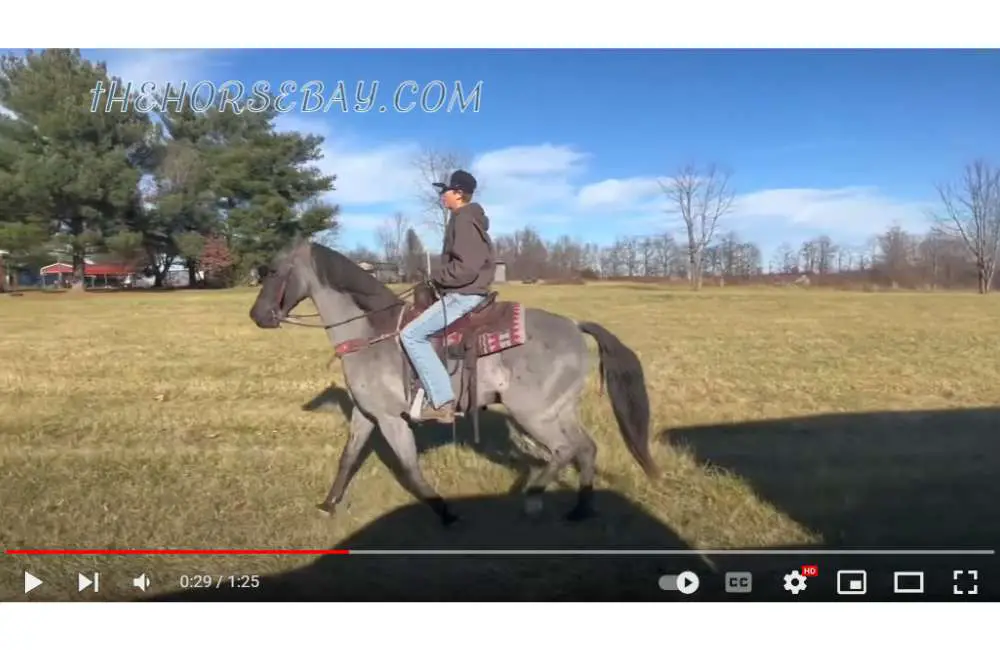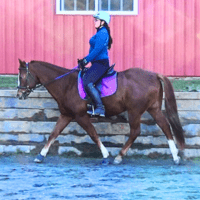There are few sights more breathtaking and stunning to see than a blue roan horse.
A beautiful animal with a coat that appears almost blue, there is little wonder that in times gone by, they were once considered mythical animals.
While horses can come in many colors and with many different markings, it is impossible to find a real blue horse. However, the blue roan is arguably one of the rarest roan colors, and it is certainly very unique-looking.
What is a blue roan horse?
Blue Roan Horse Coat Color
A blue roan is a horse coat color that gives a “blue” appearance. The horse has a black base color with a roan pattern, which is a mixture of white hairs evenly mixed across the body. The head is darker in color, and the mane, tail, and points of the horse remain a solid black.
What is a roan horse?
Roan horses can come in different colors but they all have the same roaning pattern. Roan by itself is not a breed or coat color but a coat pattern.
Roan coat patterns have white flecks of hair interspersed throughout the coat, giving an almost frosty look. The mane, tail, points of the horse and head remain a solid color, while the rest of the body has the white strands throughout.
The color of the roan horse will depend on the base coat color but it is possible to have other genes mixed in. The well known roan horse colors are bay roan, blue roan and red roan (also known as strawberry roan.)
Red roans are the most common out of the roan colors.
Blue Roan Horse Breeds
As blue roan is not considered a color breed, but there are many breeds of horses that can produce a blue roan coat.
Here is a table of some of these horse breeds and below the table you can find some more descriptions of some of these breeds.
| Breed | Description |
|---|---|
| American Paint | A breed known for its colorful coat patterns, blue roan is also an accepted color within the breed. |
| Appaloosa | While more known for their distinct spotted patterns, blue roan can be found in this breed as well. |
| Belgian | A heavy draft horse breed, blue roan can be found among Belgians, although it is less common. |
| Clydesdale | Another heavy draft breed, blue roan is not as common, but still can be found among Clydesdales. |
| Kentucky Mountain Horse | A versatile gaited breed, the Kentucky Mountain Horse can be found in blue roan color as well. |
| Missouri Fox Trotter | Another gaited breed known for its smooth trot, Missouri Fox Trotters can also be found in blue roan color. |
| Mustang | A symbol of the American West, the Mustang is a hardy breed that comes in various colors, including blue roan. |
| Racking Horse | Known for its smooth gait and versatility, Racking Horses can also be found in blue roan color. |
| Shire | A large draft horse breed, Shires can occasionally be found in blue roan color, although it is less common. |
| Standardbred | Predominantly used in harness racing, blue roan color can be found in this breed, although it is less frequent compared to American Quarter Horses. |
| Nakota Horse | A unique breed mainly found in blue roan color, they are medium-sized, hardy horses with origins in the Great Plains region of North America. |
| Percheron | A breed of draft horse originating in France, Percherons are known for their muscular stature, good temperament, and versatility, and can be found in blue roan color. |
| Welsh Pony | Blue roan is more common in Welsh Pony and Cob breeds than in some other breeds of horses, and they are known for their versatility and excellent temperament. |
| Tennessee Walking Horse | Known for their distinctive gait and powerful conformation, blue roan is a common color found in Tennessee Walking Horses. |
| Hackney | Blue roan can be found within the Hackney breed, which is known for its high-stepping action and being excellent driving horses. |
| Morgan | One of the earliest breeds developed in America, Morgans can also be found in blue roan color and are known for their versatility across various disciplines. |
| Paso Fino | Originating in Puerto Rico, the Paso Fino is a gaited breed with blue roan as a recognized color. They are popular across America and used in various disciplines. |
| Shetland Pony | Known for their strength and hardiness, Shetland Ponies come in a wide array of colors, including blue roan, and make fantastic children’s ponies due to their calm and affectionate nature. |
Blue Roan Quarter Horse
Blue roan is more common in some breeds than others and is found most often in many breeds that originated in North America, particularly in the American Quarter Horse.
Bred for their power and endurance and famous for their abilities on working ranches and in rodeos and on the barrel racing circuits.
There have been several blue roan horses over the years, some of which have proved exceptionally talented at their jobs and gone on to be prolific breeders, passing on those traits (and the color at times) to their offspring.
The blue roan is a recognized color of the quarter horse by the American Quarter Horse Association.
Standardbred
Used predominately in harness racing, the Standardbred is another breed which has the blue roan color, although it is not seen as frequently as in the American Quarter Horse.
The Standardbred is a breed that was developed in North America, although it’s origins go back to Thoroughbreds, Morgan, and Hackney horses so it’s possible that the blue roan gene evolved from those early influences.
A mostly calm breed of horse, the Standardbred makes for a good riding horse with plenty of athletic ability, although some retraining may be required if the horse had raced before beginning it’s ridden career.
Nakota Horse
Nakota horses are a beautiful and unique breed of horse that are known for their striking blue roan coloring. This is a breed that mainly comes in this color.
The Nakota is a medium-sized breed that typically stands between 14 and 16 hands high. These horses have a sturdy build with a deep chest and strong legs.
The head of a Nakota horse is relatively small in proportion to the body, and the neck is of medium length. The coat is thick and dense, which helps to protect the horse from the harsh conditions of the Great Plains. The most distinctive feature of this horse is their blue roan coloring.
The Nakota horse is a hardy breed that originated in the Great Plains region of North America. These horses were prized by the Native Americans for their strength, endurance, and agility.
They used these horses for hunting and warfare, as they were able to cover large distances quickly. They are a versatile breed that is now used for a variety of purposes including riding, as pack animals, and even racing.
The Nakota horse is also an intelligent breed that tends to be easy to train.
Percheron
The Percheron is a breed of draught horse which originated in France.
It is one of the oldest heavy draught breeds in the world and it’s origins can be traced back to around AD 800.
The modern Percheron was used by the British Army during the First World War to pull the guns due to their strength and calm nature.
The Percheron is famed for its muscular stature, good temperament, and versatility.
Welsh Pony
The blue roan is more common in the Welsh pony and cob (all four sections-A, B, C, and D) than in some other breeds of horses.
Originating in Wales, early types of Welsh ponies and cobs existed before 1600 BC, although it is thought that, like the Standardbred, they were influenced by Morgan and Hackney horses.
They are a versatile breed which, due to the different breed sections and heights, are suitable for children
right up to adults. They have had a variety of uses over the years, from pit ponies to working on farms, and latterly as riding and show ponies.
They have an excellent temperament, which makes them suitable for children, and they have smart movements, which means they usually excel in the show ring.
Tennessee Walking Horse
Blue roan is actually a common color in the Tennessee Walking Horse.
The Tennessee Walking Horse is well known for its distinctive gait, which is a four-beat lateral ambling style. This smooth gait is incredibly comfortable for riders, making the Tennessee Walking Horse a popular choice for trail riding and show horses.
But the Tennessee Walking Horse can also offer another unique trait – its ability to produce a blue roan coat.
The Tennessee Walking Horse is a breed that is known for its powerful conformation and strong legs, making it a great choice for riders looking for a horse with a lot of stamina and athleticism.
The breed is also known for its sweet disposition, which makes it an exceptional mount for riders of all levels.
Hackney
With both the Standardbred and the Welsh Pony having their origins in the Hackney breed, it could be suggested that those breeds have received their blue roan genes from the Hackney itself, and indeed, blue roans are found within the breed.
Developed in the United Kingdom, the Hackney has a high stepping action and the ability to trot at great speeds.
They are perhaps one of the smartest moving horses around and are well known as excellent driving horses – their showy action making them highly desirable horses to pull carriages with, particularly throughout the nineteenth century amongst the more well-to-do of society.
Morgan
The Morgan is another breed which seems to have had an influence in the origins of the blue roan gene, and indeed there have been several well known blue roans within the breed, including a popular dressage horse called Caduceus Herod.
The Morgan is one of the earliest breeds of horse to be developed in America and has had many jobs throughout the years.
They have been successful in harness racing, as coach horses, and were also used as Cavalry horses in the American Civil War. In more modern times they are successful across a range of disciplines, including dressage and show jumping.
Paso Fino
The Paso Fino originated in Puerto Rico, and the blue roan is a recognized color of the breed.
The Paso Fino is a particularly unique breed of horse as they are a “gaited” breed that has different gaits to usual horses which are unique to it’s own breed. They have the classic fino which is a collected show gait.
Their paso corto gait is the equivalent of a trot but is much smoother. The paso largo is a much faster gait, more like a canter or a slow gallop.
Paso Finos are a popular breed across America nowadays, and they are used in a wide variety of disciplines.
Shetland Pony
Shetland ponies are famed for their strength and hardiness and make fantastic children’s ponies due to their calm and affectionate nature.
While there is a vast array of colors and markings in Shetland ponies, the blue roan is a recognized color by the Shetland Pony Society, and it is not that rare to find a Shetland that is blue roan, although it would be harder to determine the origins of the true blue roan genetics in Shetland ponies.
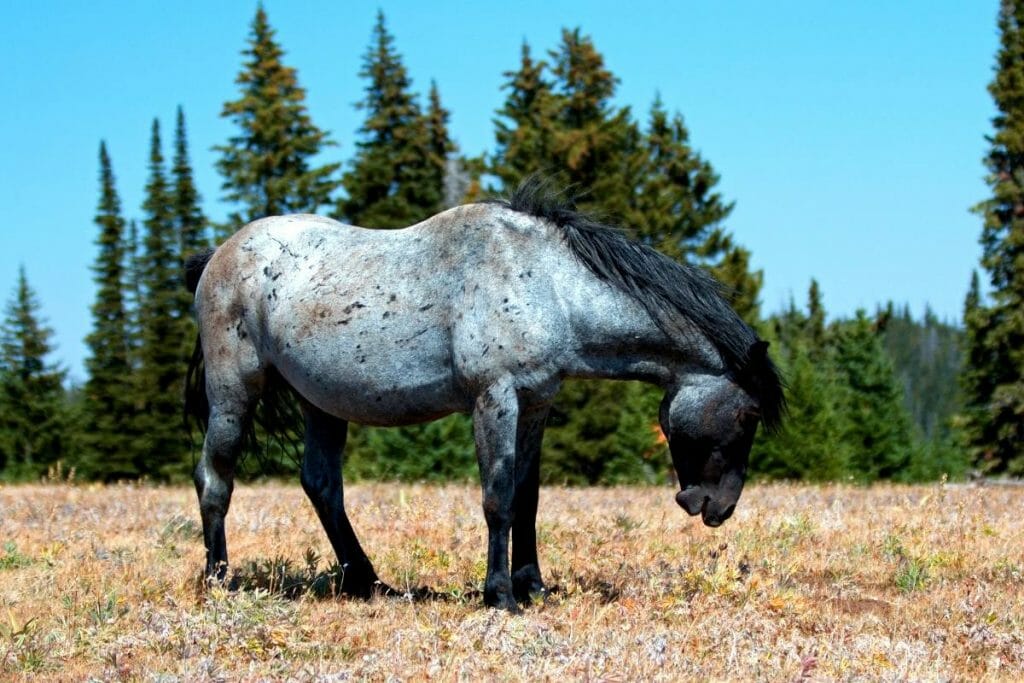
Blue Roan Genetics
The genetic make-up of horse coat colors is complex and fascinating, and the blue roan coat is no exception. The roan gene is symbolized by the “Rn” allele. The horse must have this gene to get the roaning pattern.
But before we dive into the genetics of blue roan horses, it’s important to note that sometimes there are horses that appear to have the “roan” pattern, but they are not actually a true roan.
What isn’t a roan horse? Roan Imposters
Horses may be confused with having a roan pattern for the following reasons:
- They have slight variations in their coat color and have some white hairs mingled in.
- They have some markings that look similar to roaning.
- The horse is a grey but looks similar to a roan as there coat lightens with age.
- In particular, the Rabicano color pattern is often mistaken for being a roan. This is part of the Sabino coloring. The Rabicano pattern has white hair mixed mainly around the tail and flanks, unlike the roan who would have white hairs mixed evenly across the body.
In order for a horse to be considered a “true roan,” the parents must both have the roan gene. Also the roan gene itself is a dominant gene. This is seen by the large R in the “Rn” allele.
Even if a true roan horse appears to have a parent who is not roan, the gene must be present in the parent. The parent will have some roan color in them, but it may be masked by other colors or markings, making them appear as though they are not roan.
How To Breed For A Roan Horse: Roan Horse Genetics
The three main base colors of horses are black, chestnut, and bay.
- Black genes are symbolized by “E”
- Chestnut by “e”
- Bay by “E” + “A”(Agouti gene)
To make it simple, in order to produce roans ( red, bay and blue roans, respectively), the base coat genes above must be paired with the roan gene “Rn.”
If we look deeper into the genetics of roans and particularly blue roan horses, then the “Agouti” gene (A)
determines where the black coloring will be on a horse.
- If it is recessive (aa) then the horse will be black on its legs and body.
- But if the gene is dominant (Aa or AA) then the horse will be bay if paired with a dominant black gene (EE or Ee) to produce black legs and a red body.
- If a chestnut gene is paired with a recessive black gene (ee), the horse will be chestnut.
All three of these will produce roans if combined with the roan gene (Rn).
How do you get a blue roan horse?
Therefore, to get a blue roan, the horse must carry the dominant black gene “E” for the base color and the roan gene “Rn”.
The particular circumstances under which the genetic make-up of the blue roan needs make it very difficult to intentionally breed a horse that is blue roan.
It is possible but in most circumstances you would need to know the exact DNA make-up of both potential parents, which is why, more often than not, blue roans are born by pure chance.
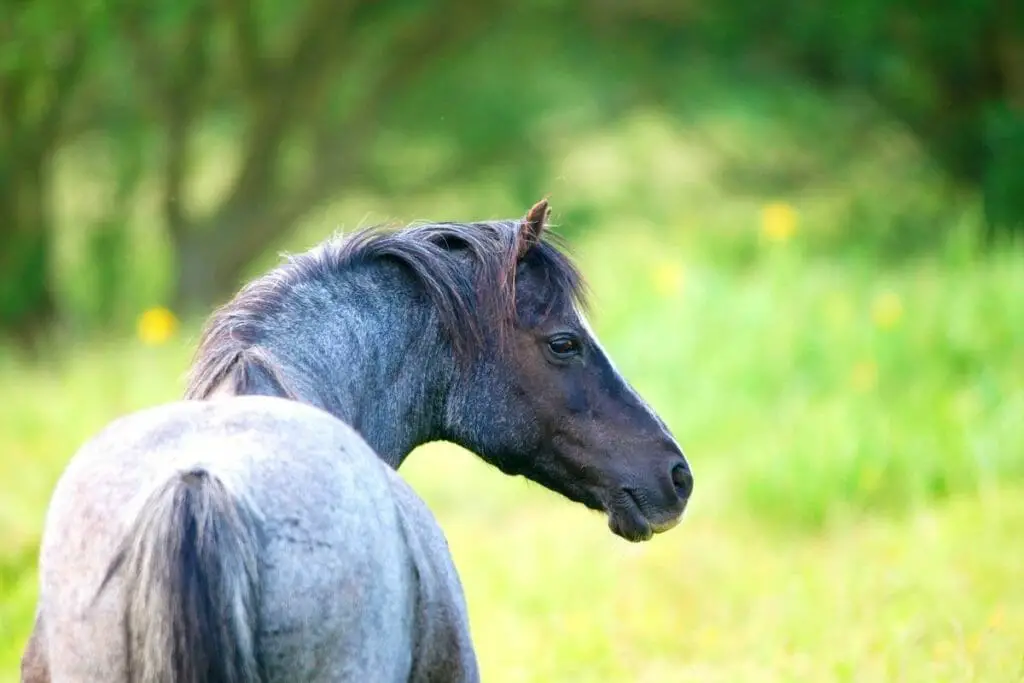
10 Blue Roan Horse Facts
Here are ten different facts about the blue roan color in horses.
1) Blue Roan Horses Are Born With Roan Pattern
When a blue roan is born, they appear to be a solid color-usually black.
However, the roan is present, but it is covered by the initial foal coat and the white hairs only appear once they begin to lose it.
2) Roan Pattern Starts To Show By 2-3 Months Old
The roan coloring starts to show by the time they are two to three months old and will usually be fully visible by the time they are a year old.
3) Blue Roans Look Darker In The Winter
Due to the longer hair of the winter coat, blue roans usually appear darker in winter.
4) Blue Roans Grow Black Hairs Over Scars
If a blue roan has a cut or scrape that scars, then the hair will grow back black over it without any white hairs, therefore creating a black mark in their roan coloring.
This is a contrast to most other colors, which would usually be scarred with white hairs.
5) Blue Roans Are Commonly Mistaken For Grey
Blue roan horses are often mistaken for grey by people unfamiliar with the coloring.
6) Blue Roan Horses Don’t Exist In Purebred Arabians
The roan gene does not exist in Arabian horses, so you will never get a true blue roan Arab, or any Arabian horse that is a true roan for that matter.
However, the Rabicano coloring is present in Arabs, and as such, they are often mistaken for roan Arab horses.
7) It Is Rare But Thoroughbreds Can Come In Blue Roan
Thoroughbreds can come in the roan pattern, but it is not common. To find a blue roan horse is even more uncommon, because black is less common in thoroughbreds.
So, to find a thoroughbred base coat black with the roan gene is very rare.
8) A Blue Roan Horse Was Portrayed In One Of Shakespeare’s Plays
Roan horses have been much revered throughout history, and in Shakespeare’s play Richard II, King Richard was portrayed as riding a roan horse.
Shakespeare also mentioned roan horses in several of his other plays.
9) Blue Valentine Was A Famous Blue Roan Horse
Blue Valentine was a blue roan stallion who was born in 1956 and became famous on the rodeo circuits.
He excelled at roping, cutting, and barrel racing, along with regular ranch work.
He became a legendary sire and died in 1980 after suffering from colic.
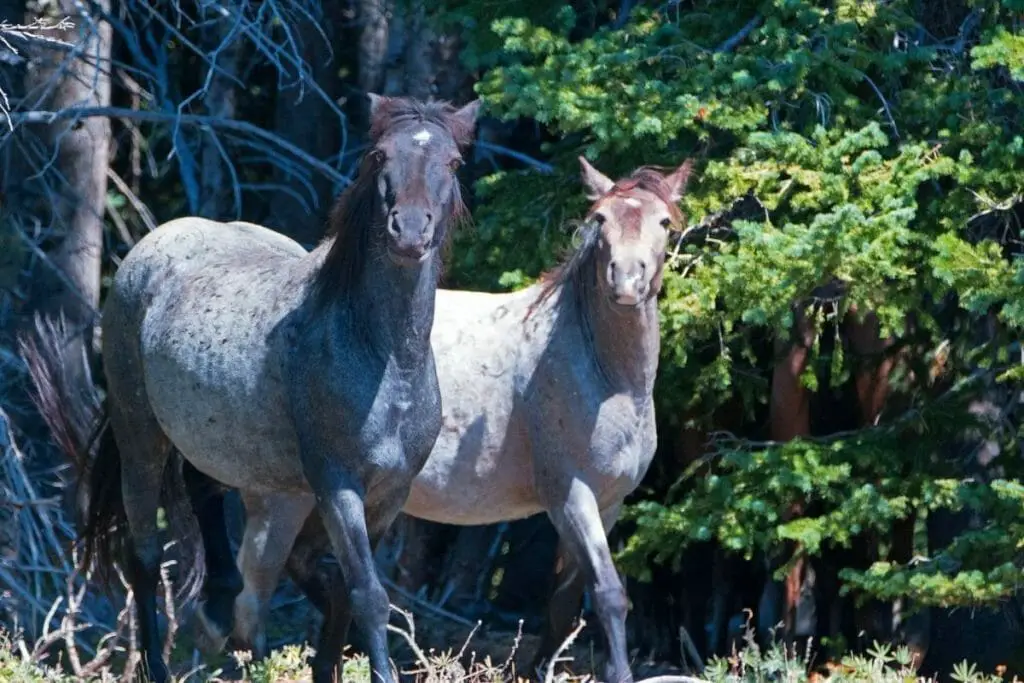
10) Dapples Are Lighter On Blue Roans
Dapples are reversed on blue roans.
Instead of having dark dapples, blue roans have light dapples which appear as lighter circles on their coat, therefore reversed.
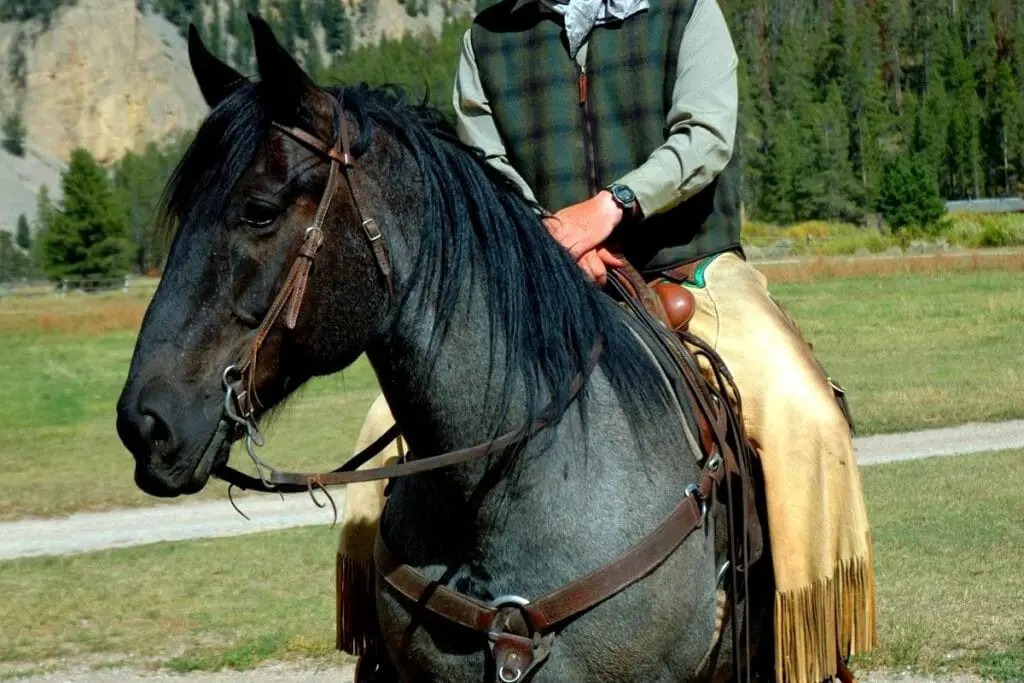
Misconceptions About The Blue Roan Horse
Here I just want to clear up some of the misinformation on the blue roan horses. Have anything else to add? Let us know in the comments at the bottom of the page.
Blue roan horses are a separate breed
In reality, blue roan is a coat color, not a specific breed. The term “blue roan” refers to the unique color pattern of a horse’s coat, characterized by a mix of black and white hairs that give it a bluish-gray appearance.
As I mentioned earlier blue roan can be found in many horse breeds, including Quarter Horses, Andalusians, and Welsh Ponies.
Blue roan horses are always born with their unique coat color
The coat color of a blue roan horse can change over time.
Some blue roan foals are born with a solid black or dark gray coat, which gradually lightens as they age and develop more white hairs.
Blue roan horses have health issues linked to their coat color
There is no evidence to suggest that the blue roan coat color itself is associated with any specific health problems in horses.
However, certain breeds that commonly exhibit the blue roan color may have breed-specific health concerns.
Blue roan horses are more valuable than other horses
The value of a horse is determined by various factors, including its breed, pedigree, conformation, and performance abilities.
While the blue roan coat color might be considered rare or desirable in certain breeds or disciplines, it does not inherently make the horse more valuable than others.
Blue roan horses are always gray
Although the term “blue roan” might suggest a grayish color, blue roan horses can exhibit a range of shades, from dark blue to lighter silver hues.
This variation is due to the distribution of black and white hairs in the horse’s coat.
Blue roan horses have blue eyes
The eye color of a blue roan horse is not related to its coat color. Blue roan horses can have brown, amber, or blue eyes, depending on their genetics.
Blue eyes are more commonly associated with horses that carry the “splash white” or “frame overo” genes, which can also be present in blue roan horses but are not specific to the coat color.
Blue Roan Horse Names
If you’re lucky enough to own a blue roan horse, then you’re going to need a good name to go with it.
I think it’s pretty obvious what the top names for a blue roan horse are going to be, but there’s still plenty more to choose from here if they don’t take your fancy.
- Azure
- Spirit Blue
- Blue Belle
- Blue Jeans
- Blue Lagoon
- Blue Moon
- Blue Velvet
- Blueberry Bliss
- Casper
- Celestial Mist
- Cloud
- Cobalt Charm
- Diamond Frost
- Ghost
- Indigo Dream
- Lightening
- Midnight
- Midnight Haze
- Mist
- Misty
- Misty
- Melody Moonlit
- Shadow
- Ocean Breeze
- Sapphire Sky
- Silver
- Silver Moonbeam
- Skye
- Smoky Sapphire
- Steel
- Storm
- Stormy River
- Starry Night
- Thunder
- Thundercloud
- Twilight Whispers
- Whispering Wind

Blue Roan FAQ’s
Do blue roan horses turn white?
Blue roans do not turn white, unlike grey horses which get progressively lighter as they get older.
A blue roan horse remains the same color throughout it’s life, although they can appear darker in the winter due to the longer hair of the winter coat.
What is a true blue roan horse?
A true blue roan horse has a black base color on it’s body with white hair mixed in evenly throughout it’s body, giving the appearance of a blue color.
The head and legs are black. The true blue roan must also be from parents who were both roans.
Is a blue roan horse rare?
While not rare as some other coat colors, the blue roan horse is one of the least common coat colors of the roan colored horses.
It is also more rare in certain breeds like the Thoroughbred.
Are blue roan horses expensive?
Blue roan horses should not be more expensive than other horses of the same breed or caliber.
Although some may be willing to pay more for a blue roan just because of it’s distinct and unique coat color pattern.
Can a blue roan horse change color as it ages?
Yes, the coat color of a blue roan horse can change over time. Some blue roan foals are born with a solid black or dark gray coat, which gradually lightens as they age and develop more white hairs.
The intensity and distribution of the roan pattern may also change with age, although the basic blue roan coloration remains.
How can I ensure that my blue roan horse maintains its unique coat color?
There is no specific method to maintain the coat color of a blue roan horse, as it is genetically determined. However, regular grooming, proper nutrition, and sun protection can help keep your horse’s coat healthy and vibrant, which may enhance its natural coloration.
Do blue roan horses have specific temperament traits or behavioral characteristics?
Blue roan horses do not have specific temperament or behavioral traits linked to their coat color. Temperament and behavior are primarily influenced by factors such as breed, genetics, and upbringing, rather than coat color.
What disciplines or equestrian sports are blue roan horses commonly seen in?
Blue roan horses can be found in various equestrian disciplines and sports, depending on their breed and individual abilities. They can be seen in dressage, show jumping, eventing, western riding, trail riding, and many other activities, just like horses of any other coat color.
How can I identify a true blue roan horse from other similar coat colors, like gray or grulla?
A true blue roan horse has a consistent mixture of white and black hairs throughout its body, creating a bluish-gray appearance.
Gray horses typically have a more solid base color that lightens with age, eventually turning white or fleabitten gray.
Grulla horses have a distinct dun factor, including a dorsal stripe, and their base color is often more silvery or mouse-gray, rather than the blue tint of a blue roan.
Can two non-roan horses produce a blue roan foal?
It is possible for two non-roan horses to produce a blue roan foal if both parents carry a hidden roan gene.
The roan gene (Rn) is inherited in an autosomal dominant manner, meaning that if one parent passes the gene to the offspring, the foal will have a roan coat color. However, if neither parent visibly displays the roan pattern, it is less likely that they will produce a blue roan foal.
What is the history behind the blue roan coat color in horses?
The history of the blue roan coat color in horses is not well-documented, as it is a naturally occurring color that can be found across many breeds and geographic regions.
The roan pattern has been present in horses for thousands of years and can be seen in ancient artwork and historical records, demonstrating the long-standing presence of roan horses, including blue roans, in human history.
Wrapping Up
You now know blue roan horses are not actually blue but a genetically black horse with a white pattern gene called roan.
They are born with the roan pattern and keep it throughout their life.
So we went over the genetics, facts about blue roans, breeds that can come in the color, even names if you decide to buy a blue roan.
They are a unique and gorgeous color of horse. But only one of many horse coat colors.
Do you ride any bay horses? Be sure to read my blog post all about the base color bay and variations that come from bay.
Cheers, Kacey
Related Blog Posts
- 16 Dapple Grey Horse Facts With Beautiful Pictures | Breeds List | Resources
- What Is A Flea Bitten Grey Horse? Grey Horse Breeds, Facts, Colors & Photos
- Learn 10 Facts, Differences & Color Shades Of Buckskin & Dun Horses
- 27 Interesting Palomino Horse Facts With Beautiful Pictures & Some Extras
- Horse Coat Patterns for the American Paint Horse

